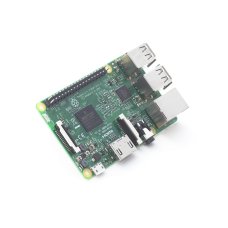
These 4 channels can provide PWM (Pulse Width Modulation) outputs. Hardware PWM available on GPIO12, GPIO13, GPIO18, GPIO19 TWI (Two Wire Interface) Interface can be used to connect peripherals.Īlthough these some pins have multiple functionsthey can be considered as I/O pins. SPI (Serial Peripheral Interface) used for communicating with other boards or peripherals. UART (Universal Asynchronous Receiver Transmitter) used for interfacing sensors and other devices. PI board is specifically designed for hobbyist and engineers who are interested in LINUX systems and IoT (Internet of Things). The board not only has tons of features it also has terrific processing speed making it suitable for advanced applications.

It can be considered as a single board computer that works on LINUX operating system. Step 5.RASPBERRY PI 3 is a development board in PI series. More about ThingsBoard Rule Engine queues see in documentation.
Raspberry pi 3 model b os update#
You can update default Rule Engine queues configuration using UI. # Sample parameters to fit into 10 requests per second on a "monolith" deployment: export TB_QUEUE_CORE_POLL_INTERVAL_MS =1000 # By UI set the parameters - interval (1000) and partitions (1) for Rule Engine queues. # Number of requests to particular Message Queue is calculated based on the formula: # ((Number of Rule Engine and Core Queues) * (Number of partitions per Queue) + (Number of transport queues) # + (Number of microservices) + (Number of JS executors)) * 1000 / POLL_INTERVAL_MS # For example, number of requests based on default parameters is: # Rule Engine queues: # Main 10 partitions + HighPriority 10 partitions + SequentialByOriginator 10 partitions = 30 # Core queue 10 partitions # Transport request Queue + response Queue = 2 # Rule Engine Transport notifications Queue + Core Transport notifications Queue = 2 # Total = 44 # Number of requests per second = 44 * 1000 / 25 = 1760 requests # Based on the use case, you can compromise latency and decrease number of partitions/requests to the queue, if the message load is low.
Raspberry pi 3 model b os password#
More about ThingsBoard Rule Engine queues see in documentation.Įxport TB_QUEUE_PUBSUB_PROJECT_ID =YOUR_PROJECT_IDĮxport TB_QUEUE_PUBSUB_SERVICE_ACCOUNT =YOUR_SERVICE_ACCOUNTĮxport TB_QUEUE_SERVICE_BUS_NAMESPACE_NAME =YOUR_NAMESPACE_NAMEĮxport TB_QUEUE_SERVICE_BUS_SAS_KEY_NAME =YOUR_SAS_KEY_NAMEĮxport TB_QUEUE_SERVICE_BUS_SAS_KEY =YOUR_SAS_KEYĮxport TB_QUEUE_KAFKA_USE_CONFLUENT_CLOUD = trueĮxport TB_QUEUE_KAFKA_REPLICATION_FACTOR =3Įxport TB_QUEUE_KAFKA_CONFLUENT_SASL_JAAS_CONFIG =. required username = "CLUSTER_API_KEY" password = "CLUSTER_API_SECRET" } # These params affect the number of requests per second from each partitions per each queue. You can update default Rule Engine queues configuration (poll interval and partitions) using UI.


# Sample parameters to fit into 10 requests per second on a "monolith" deployment: export TB_QUEUE_CORE_POLL_INTERVAL_MS =1000Įxport TB_QUEUE_RULE_ENGINE_POLL_INTERVAL_MS =1000Įxport TB_QUEUE_TRANSPORT_REQUEST_POLL_INTERVAL_MS =1000Įxport TB_QUEUE_TRANSPORT_RESPONSE_POLL_INTERVAL_MS =1000Įxport TB_QUEUE_TRANSPORT_NOTIFICATIONS_POLL_INTERVAL_MS =1000 # These params affect the number of requests per second from each partitions per each queue. Export TB_QUEUE_AWS_SQS_ACCESS_KEY_ID =YOUR_KEYĮxport TB_QUEUE_AWS_SQS_SECRET_ACCESS_KEY =YOUR_SECRETĮxport TB_QUEUE_AWS_SQS_REGION =YOUR_REGION


 0 kommentar(er)
0 kommentar(er)
